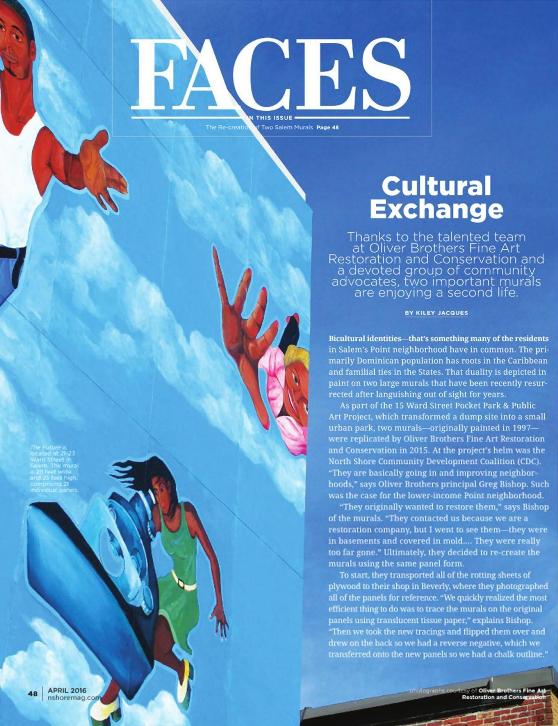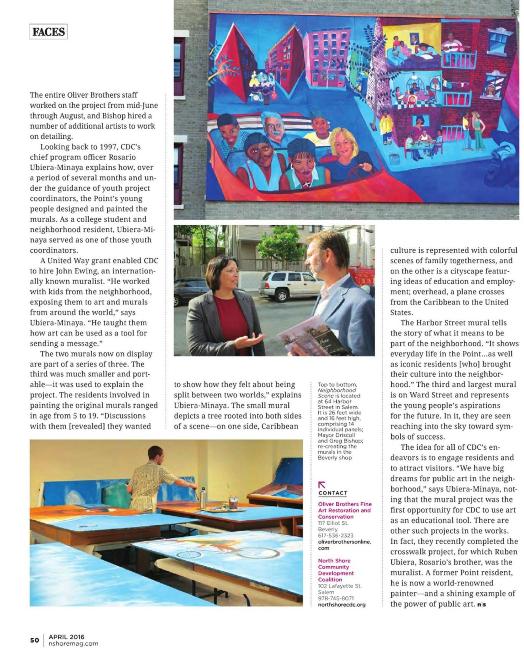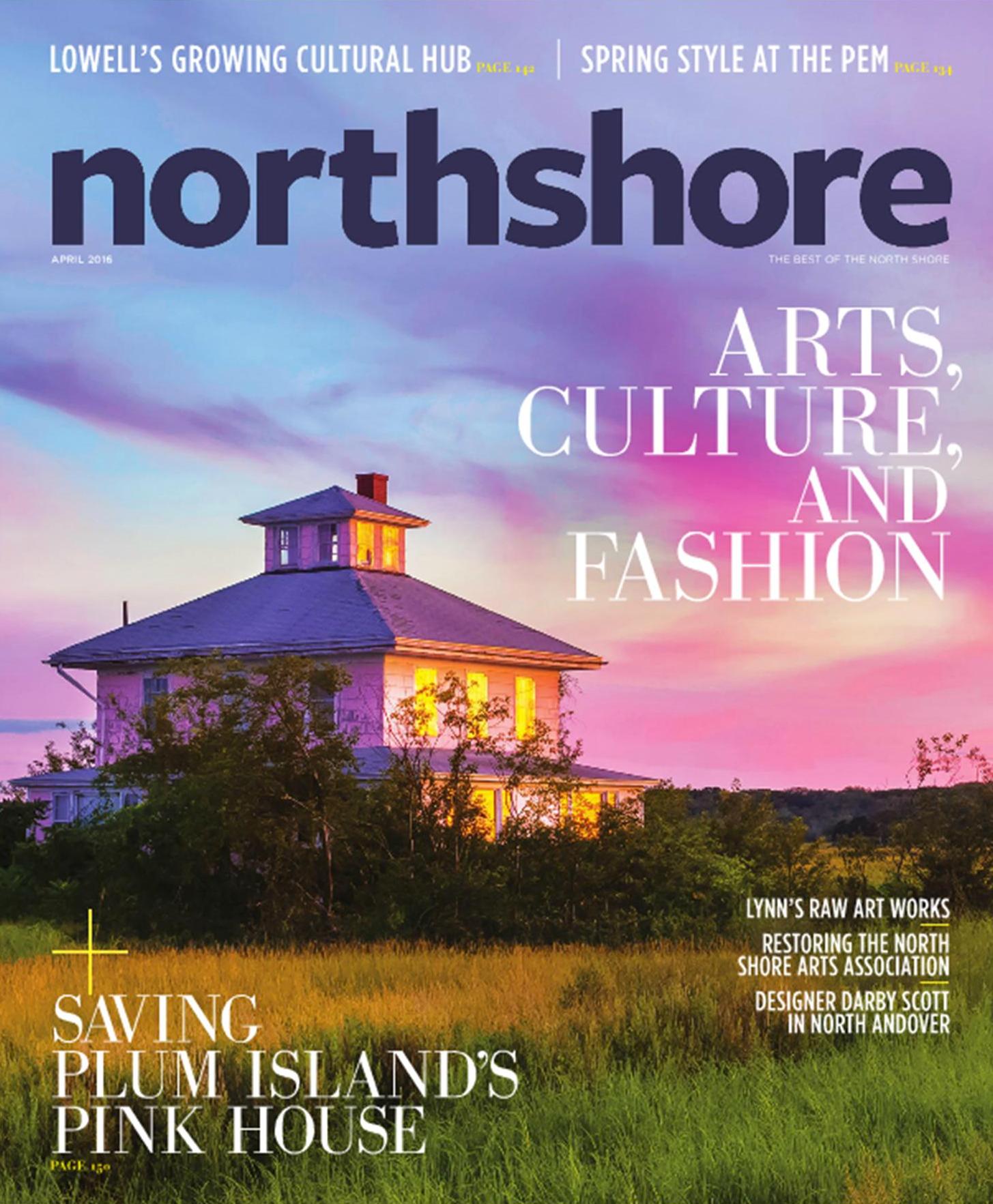Two murals originally painted in 1997, were replicated by Oliver Brothers Art Restoration and Conservation in 2015.
The Future mural is located at 21-23 Ward Street, Salem, MA. The mural is 28’ wide and 25’ high comprising of 21 individual panels. Neighborhood Scene mural is located at 64 Harbor Street in Salem. It is 26 feet wide and 16 feet high, comprising 14 individual panels.

Cultural Exchange

Photos: Top to bottom
- Neighborhood Scene is located at 64 Harbor Street in Salem. It is 26 feet wide and 16 feet high, comprising 14 individual panels
- Mayor Driscoll and Greg Bishop
- re-creating the murals in the Beverly shop

CULTURAL EXCHANGE
Thanks to the talented team
at Oliver Brothers fine Art Restoration and Conservation
and a devoted group of community advocates,
two important murals are enjoying a second life.
By KILEY JACQUES
Bicultural identities—that’s something many of the residents in Salem’s Point neighborhood have in common. The primarily Dominican population has roots in the Caribbean and familial ties in the States. That duality is depicted in paint on two large murals that have been recently resurrected after languishing out of sight for years. As part of the 15 Ward Street Pocket Park & Public Art Project, which transformed a dump site into a small urban park, two murals—originally painted in 1997—were replicated by Oliver Brothers tine Art Restoration and Conservation in 2015.
At the project’s helm was the North Shore Community Development Coalition (CDC). -They are basically going in and improving neighborhoods,” says Oliver Brothers principal Greg Bishop. Such was the case for the lower-income Point neighborhood.
They originally wanted to restore them,” says Bishop of the murals. “They contacted us because we are a restoration company, but I went to see them—they were in basements and covered in mold…. They were really too far gone.” Ultimately, they decided to re-create the murals using the same panel form.
To start, they transported all of the rotting sheets of plywood to their shop in Beverly, where they photographed all of the panels for reference. “We quickly realized the most efficient thing to do was to trace the murals on the original panels using translucent tissue paper,” explains Bishop. -Then we took the new tracings and flipped them over and drew on the back so we had a reverse negative, which we transferred onto the new panels so we had a chalk outline.”
The entire Oliver Brothers staff worked on the project from mid-June through August, and Bishop hired a number of additional artists to work on detailing.
Looking back to 1997, CDC’s chief program officer Rosario Ubiera-Minaya explains how, over a period of several months and under the guidance of youth project coordinators, the Point’s young people designed and painted the murals. As a college student and neighborhood resident, Ubiera-Minaya served as one of those youth coordinators.
A United Way grant enabled CDC to hire John Ewing, an internationally known muralist. “He worked with kids from the neighborhood, exposing them to art and murals from around the world,” says Ubiera-Minaya. “He taught them how art can be used as a tool for sending a message.”
The two murals now on display are part of a series of three. The third was much smaller and portable—it was used to explain the project. The residents involved in painting the original murals ranged in age from 5 to 19. “Discussions with them [revealed) they wanted to show how they felt about being split between two worlds,” explains Ubiera-Minaya. The small mural depicts a tree rooted into both sides of a scene—on one side, Caribbean culture is represented with colorful scenes of family togetherness, and on the other is a cityscape featuring ideas of education and employment; overhead, a plane crosses from the Caribbean to the United States.
The Harbor Street mural tells the story of what it means to be part of the neighborhood. “It shows everyday life in the Point…as well as iconic residents [who) brought their culture into the neighborhood.” The third and largest mural is on Ward Street and represents the young people’s aspirations for the future. In it, they are seen reaching into the sky toward symbols of success.
The idea for all of CDC’s endeavors is to engage residents and to attract visitors. “We have big dreams for public art in the neighborhood,” says Ubiera-Minaya, noting that the mural project was the first opportunity for CDC to use art as an educational tool. There are other such projects in the works. In fact, they recently completed the crosswalk project, for which Ruben Ubiera, Rosario’s brother, was the muralist. A former Point resident, he is now a world-renowned painter—and a shining example of the power of public art.
Photographs courtesy of Oliver Brothers Fine Art Restoration and Conservation.
Contact Oliver Brothers or call us to schedule an appointment at 617-536-2323
"*" indicates required fields